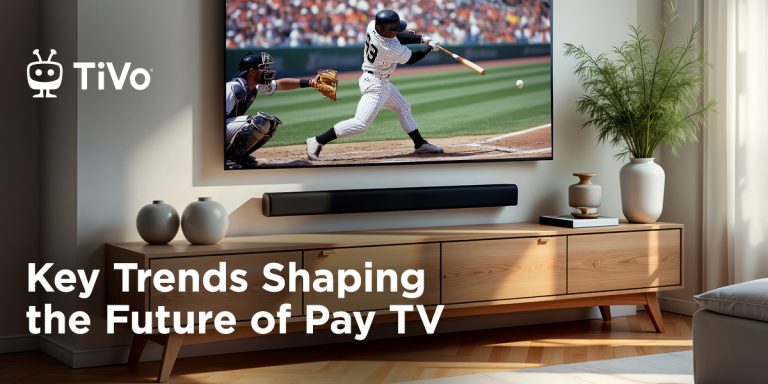As pay TV operators and internet service providers (ISPs) navigate a rapidly evolving video consumption landscape, understanding current trends is crucial for maintaining a competitive advantage and enhancing user engagement. The latest insights from the TiVo Q4 2024 Video Trends Report reveal significant patterns and shifts in viewer behavior that can inform strategic decisions. Three key trends are shaping the future of pay TV and broadband. Together, they help signal where the industry is headed — and where opportunities lie.
Trend 1: Decreased intentions to cut the cord
Despite the growing popularity of streaming platforms, the allure of pay TV remains strong, with a notable decrease in consumers planning to cut the cord. According to the Video Trends Report, only 25.7% of respondents anticipate discontinuing their pay TV services in the next six months — a decrease from 27.6% the previous year. This trend highlights an upturn in the value offered by traditional pay TV, especially as consumers encounter the limitations and rising costs of multiple streaming subscriptions.
The centralized advantage of pay TV
Pay TV provides a centralized source for diverse content, including live events, sports and local programming that streaming services often can’t match. This convenience is crucial as viewers look for comprehensive and hassle-free entertainment solutions. Moreover, the average monthly entertainment spending dropped by roughly $20 year over year, from $176.84 to $157.47. This presents a timely opportunity to position pay TV services as both cost-effective and rich in content. By emphasizing reliability and variety, providers can better attract cost-conscious consumers and reduce churn.
Trend 2: Sports as a cornerstone for pay TV
Live sports continue to be a significant draw for pay TV subscriptions. The immediacy and reliability of pay TV broadcasting make it the preferred choice for sports fans who demand uninterrupted and high-quality coverage of their favorite events. A sizeable 77.9% of respondents said they regularly watch sports, and 40.3% of them said they rely primarily on pay TV for their sports content.
The unmatched sports experience
As viewers continue to rely on pay TV for a seamless sports experience, the value of pay TV in delivering live game-day coverage cannot be overstated. As streaming platforms struggle with issues like delays and buffering, pay TV stands out by offering real-time broadcasts, free from the frustrations of technical disruptions. This reliability is crucial during major sporting events when every moment counts, ensuring that fans never miss a critical play or performance. For pay TV operators and ISPs, this presents a key differentiator in an increasingly competitive market. It also opens the door to strategic partnerships with sports networks and advertisers seeking dependable platforms.
Trend 3: Increasing engagement with home screen ads
Advertising preferences and tolerances are shifting, with pay TV subscribers showing a higher likelihood of engaging with ads, particularly those on the home screen. The report indicates that 70.4% of those with a smart TV have noticed information about a TV show or movie on the home screen, and 57.3% would be more willing to see these ads if they were personalized to their viewing taste. For pay TV subscribers, 71.3% reported regularly using the information about a TV show or movie on the home screen to start watching that content.
Innovations in targeted advertising
The trend towards more personalized and less intrusive advertising is clear. As viewers grow more accepting of ads, especially those tailored to their preferences and viewing habits, there is an opportunity for providers to innovate in how they deliver advertisements. AI-powered personalization can enhance the relevance and effectiveness of advertising, turning it into a value-added aspect of the viewer experience rather than a disruption. For operators and ISPs, this can lead to new revenue streams through targeted ad partnerships and premium advertiser offerings — unlocking higher returns while maintaining customer satisfaction.
Adapting to viewer preferences for continued relevance
The staying power of pay TV highlights viewer preferences, where variety, cost-effectiveness and reliable access to preferred content, like live sports, are paramount. As the media landscape continues to evolve, pay TV providers and ISPs are well-positioned to meet these needs by leveraging trends in content aggregation, personalization and innovative advertising. By focusing on what subscribers value most, providers can not only retain current customers but also win back viewers who might have switched to streaming services. Embracing these trends isn’t just smart — it’s critical to staying competitive and relevant.
Download the TiVo Q4 2024 Video Trends Report for more key insights on subscriber behavior, entertainment spending, retention strategies and more.


Comments are closed.